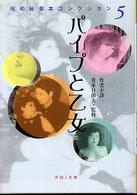- ホーム
- > 洋書
- > 英文書
- > Literary Criticism
Full Description
This volume introduces readers to classical Chinese literature from its beginnings (ca. 10th century BCE) to the tenth century CE. It asks basic questions such as: How did reading and writing practices change over these two millennia? How did concepts of literature evolve? What were the factors that shaped literary production and textual transmission? How do traditional bibliographic categories, modern conceptions of genre, and literary theories shape our understanding of classical Chinese literature? What are the recurrent and evolving concerns of writings within the period under purview? What are the dimensions of human experience they address? Why is classical Chinese literature important for our understanding of pre-modern East Asia? How does the transmission of this literature in Japan, Korea, and Vietnam define cultural boundaries? And what, in turn, can we learn from the Chinese-style literatures of Japan, Korea, and Vietnam, about Chinese literature? In addressing these questions, The Oxford Handbook of Classical Chinese Literature departs from standard literary histories and sourcebooks. It does not simply categorize literary works according to periods, authors, or texts. Its goal is to offer a new conceptual framework for thinking about classical Chinese literature by defining a four-part structure. The first section discusses the basics of literacy and includes topics such as writing systems, manuscript culture, education, and loss and preservation in textual transmission. It is followed by a second section devoted to conceptions of genre, textual organization, and literary signification throughout Chinese history. A third section surveys literary tropes and themes. The final section takes us beyond China to the surrounding cultures that adopted Chinese culture and produced Chinese style writing adapted to their own historical circumstances. The volume is sustained by a dual foci: the recuperation of historical perspectives for the period it surveys and the attempt to draw connections between past and present, demonstrating how the viewpoints and information in this volume yield insights into modern China and east Asia.
Contents
TABLE OF CONTENTS
Acknowledgements
Contributor List
Timeline of Chinese Dynasties
SECTION ONE: INTRODUCTION
1. Key Concepts of "Literature" (Stephen Owen)
2. Periodization and Major Inflection Points (Stephen Owen)
SECTION TWO: BASICS OF LITERACY
I. Technology and Media
Editor's Introduction (Xiaofei Tian)
3. The Chinese Writing System (Imre Galambos)
4. Literary Media: Writing and Orality (Christopher M. B. Nugent)
5. Manuscript Culture (Christopher M. B. Nugent)
6. The Relationship of Calligraphy and Painting to Literature (Ronald Egan)
II. Institutions of Literary Culture
Editor's Introduction (Xiaofei Tian)
7. Education and the Examination System (Rebecca Doran)
8. Text and Commentary: The Early Tradition (Michael Puett)
9. Text and Commentary in the Medieval Period (Yu-yu Cheng)
10. Literary Learning: Encyclopedias and Epitomes (Xiaofei Tian)
11. Libraries, Book Catalogues, Lost Writings (Glen Dudbridge)
SECTION THREE: LITERARY PRODUCTION
I. Traditional Genre Spectrum
Editor's Introduction (Wai-yee Li)
12. Classics (David Schaberg)
13. Histories (Stephen Durrant)
14. Masters (Wiebke Denecke)
15. Collections (Xiaofei Tian)
II. Modern Perspectives on Genre
Editor's Introduction (Wai-yee Li)
16. "Chinese Poetry" (Paul Rouzer)
17. Elite versus Popular Literature (Wilt Idema)
18. Narrative Genres (Sarah Allen)
III. Collecting, Editing, Transmitting
Editor's Introduction (Xiaofei Tian)
19. Pre-Tang Anthologies and Anthologization (David R. Knechtges)
20. Anthologies in the Tang (Paul W. Kroll)
21. The Song Reception of Earlier Literature (Stephen Owen)
22. Textual Transmission of Earlier Literature during the Yuan, Ming, and Qing Dynasties (Wai-yee Li)
IV. Literature and Metaliterature
Editor's Introduction (Wiebke Denecke)
23. Defenses of Literature/Literary Thought/Poetics (Paul Rouzer)
24. Concepts of Authorship (Wai-yee Li)
25. Tradition Formation: Beginnings to Eastern Han (Stephen Durrant)
26. Classicisms in Chinese Literary Culture: Six Dynasties through Tang (Anna Shields)
SECTION FOUR: MOMENTS, SITES, FIGURES
Editor's Introduction (Wai-yee Li)
27. Moments (Paula Varsano)
28. Sites I (Jack Chen)
29. Sites II (Wendy Swartz)
30. Figures (Wai-yee Li)
SECTION FIVE: EARLY AND MEDIEVAL CHINA AND THE WORLD
Editor's Introduction (Wiebke Denecke)
31. Colonization, Sinicization, and the Multigraphic Northwest (Tamara T. Chin)
32. Translation (Daniel Boucher)
33. Shared Literary Heritage in the Sinographic Sphere (Wiebke Denecke, with contributions by Nam Nguyen)
34. Sino-Korean Literature (Sim Kyung-ho and Peter Kornicki)
35. Early Sino-Japanese Literature (Wiebke Denecke)
36. Sino-Vietnamese Literature (Peter Kornicki)








